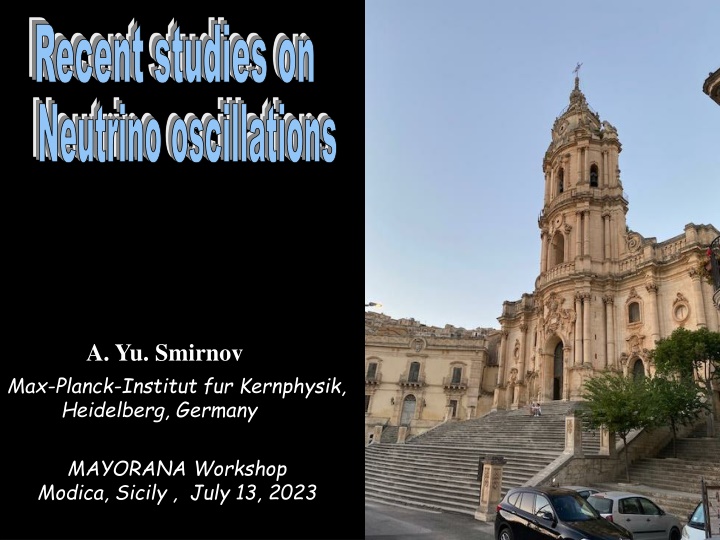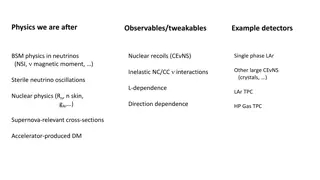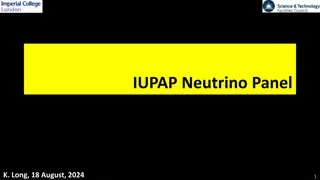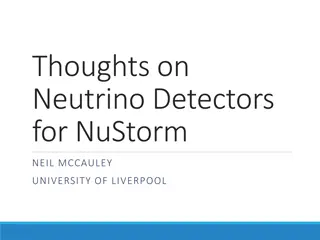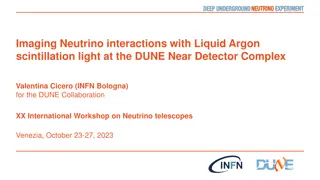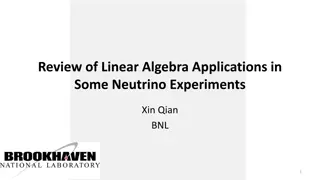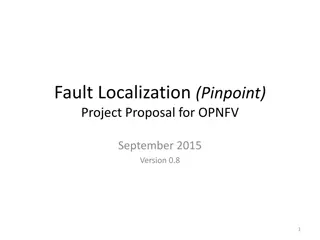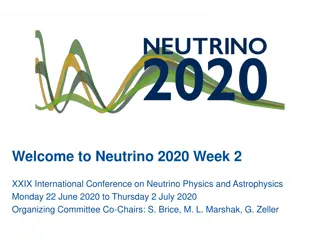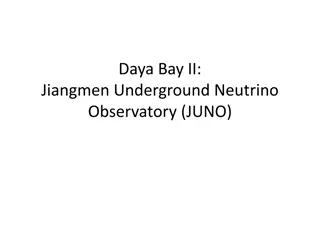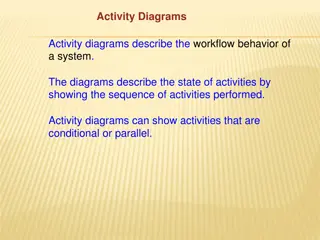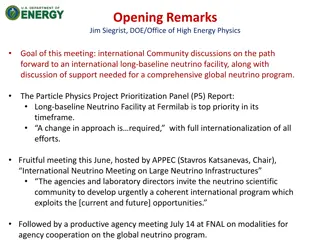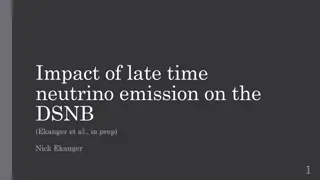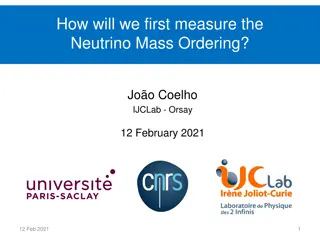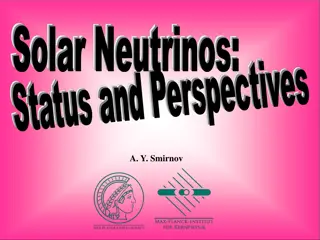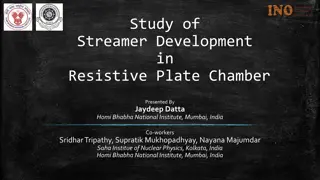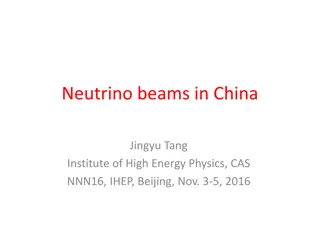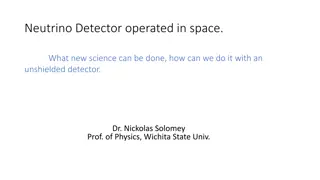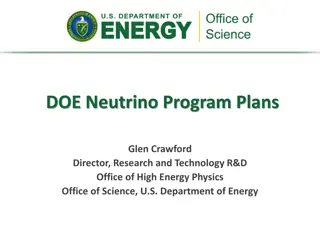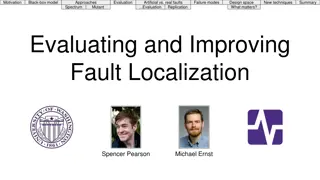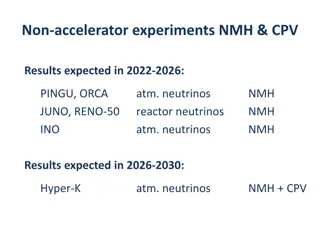Recent Studies on Neutrino Oscillations: Space-Time Localization Diagrams
Recent studies on neutrino oscillations explore space-time localization diagrams, propagation, quantum decoherence, and detection coherence times. These diagrams visualize oscillation amplitudes, interference effects, and production processes in neutrino interactions.
Download Presentation

Please find below an Image/Link to download the presentation.
The content on the website is provided AS IS for your information and personal use only. It may not be sold, licensed, or shared on other websites without obtaining consent from the author.If you encounter any issues during the download, it is possible that the publisher has removed the file from their server.
You are allowed to download the files provided on this website for personal or commercial use, subject to the condition that they are used lawfully. All files are the property of their respective owners.
The content on the website is provided AS IS for your information and personal use only. It may not be sold, licensed, or shared on other websites without obtaining consent from the author.
E N D
Presentation Transcript
Recent studies on Neutrino oscillations A. Yu. Smirnov Max-Planck-Institut fur Kernphysik, Heidelberg, Germany MAYORANA Workshop Modica, Sicily , July 13, 2023
Content Propagation and quantum decoherence
m412 = 1 - 2 eV2 Space-time LSND localization diagrams reflect computations of oscillation amplitudes in QFT, visualizes various subtle issues
time localization diagram E.Kh. Akhmedov, D. Hernandez, A.Y.S. 1201.4128 [hep-ph] A.Y.S. 2212.10242 [hep-ph] Produced and propagated neutrino state | P>= 1P| 1 > + 2P| 2 > the wave packets with time width tP, vi - group velocities iP = iP(x vit) Detected state | D>= 1D| 1 > + 2D| 2 > iD = iD(x xD, t tD) - the detection WP, time width tD Amplitude: projection of propagated state onto detection state. L- baseline For simplicity iD(x xD, t tD) = (x L) iD(t tD) A (L, tD) = < D| P>= i Ai(L, tD) = i dt iD* (t tD) iP(L vit) generalized WP
Space time localization diagram Oscillation probability P (L) = dtD|A(L, tD)|2 = dtD [|A1(L, tD)|2 + |A2(L, tD)|2] x distance + 2Re dtD A1(L, tD)*A2(L, tD) interference Here we considered elementary processes of interactions t time Further integration over interval of baseline L due to finite sizes of the source and detector N N + e- + The slopes of bands are determined by group velocities
Detection two extreme cases tD >> tP tD << tP short detection coherence time iD(t tD) ~ (t tD) long detection coherence time Ai(L, tD) ~ iD(L/v - tD) Ai(L, tD) ~ iP(L vitD) restoration of coherence if Interference is determined by overlap of produced WP tD >> tsep
Production E.Kh. Akhmedov and A.Y.S. [hep-ph] WP s are determined by localization region of the production process: by overlap of localization regions of all particles involved but neutrinos. N N + e- + Consider decay, If N and e- are not detected or their interactions can be neglected localization of process is given by localization of atom N distance The latter is determined by time between two collisions of N, tN x ~ v tN ~ XN c/vN time enhancement factor for length of neutrino WP
Entanglement and correlations If N or/and e- are detected or interact, this may narrow their WP s and consequently the neutrino WP. If e- is detected during time interval te < tN, the size of WP will be determined by te tcoll distance If e- interacts with particles of medium which have very short time between collisions tcoll, then x ~ ctcoll Similar to the EPR paradox emission and interactions of e- should be considered as unique process; contributions to its amplitude from different e-interactions regions appear with random phases k incoherent Atot = Ak ei k time
Wave packets and QFT Eventually the oscillation probability depends on localization of external particles and baseline L. L. Stodolsky Neutrino WP are unnecessary , at least in setups without time tagging Neutrinos play the role of transmitter of information from production region to the detection region Complete QFT consideration which confirms these statements including results on decoherence: R. Krueger , T Schwetz 2303.15524 [hep-ph]
m412 = 1 - 2 eV2 Propagation decoherence LSND Recent activity is related to reactor and Ga source oscillation searches, attempts to measure size of neutrino WP
Observing propagation decoherence x t space: separation of wave packets of mass states due to difference of group velocities equivalent to integration over the energy uncertainty f(E) E ~ 1/ x x E x Suppression of interference damping of oscillations Survival probability : Pee = Pee + D(E, L) sin2 2 cos Damping factor for Gaussian WP D(E, L) = exp [- (L/Lcoh)2] Coherence length Lcoh = x Information is not lost and can be restored at detection E2 m2
Decoherence of reactor neutrinos A de Gouvea, V De Romeri, C.A. Termes, 2104.05806 [hep-ph] Bound on size of the WP KamLAND Daya Bay, RENO Expected damping effect Absence of decoherence (damping) effect means L << Lcoh m2 2E2 x > L Analysis of data: x > 2.1 x 10-11 cm (90% C.L.) The bound corresponds to the energy resolution of detectors E x ~ 1/ E
Other studies Daya Bay: decoherence due to finite momentum spread p p /p < 0.23 (95% C.L.) for p = 3 MeV: x ~ 1/ E = 2.8 x 10-11 cm F.P. An, et al, 1608.01661 [hep-ex] JUNO in future may set the limit p /p < 10-2 (95% C.L.) J. Wang et al. 2112.14450 [hep- ex] x > 2.3 x 10-10 cm C.A.Arguelles et al, 2201.05108 [hep-ph] Decoherence in oscillations of active eV scale sterile Damping effects in various experiments computed for x = 2.1 x 10-11 cm (as found in A de Gouvea et al).
WPs of reactor neutrinos Source: -decays of fragments N of nuclear fission N N + e- + N quickly thermalize in equilibrium with medium in the moment of decay the average velocity: vN ~ [3T/ mN]-1/2 If N and e- are not detected or their interactions can be neglected, localization of production process is given by localization of N. x ~ v tN ~ XN c/vN tN - time between two collisions of N with other atoms tN ~ [ AA nU vN]-1 AA geometric cross-section AA ~ (2rvdW) 2 Van der Waals radius nU - number density of Uranium x = 2.8 x 10-3 cm
Effect of accompanying particles Consideration of x-t localization of interactions of accompanying particles. Duration of production process is given by the shortest mean free time among particles involved Chain of k processes of secondary interactions till equilibration (thermalization) Electrons have the shortest t = te = Xe/ve Xe is determined by ionization of uranium, eU ... e + A e + A A i Xe = (nU eU)-1 N te t ~ tN /2k x = 2 x 10-5 cm x = (5 10)x 10-5 cm short cut estimation: can be considered as the upper bound
Implications 1. x >> xexp x / xexp = 105 - 106 2. Corresponding energy uncertainty while energy resolution E ~ 105 eV To be sensitive to WP separation energy resolution function should be known with better that 10-5 accuracy E ~ 1 eV For Cr source: x = 1.4 x 10-4 cm 3. Large m2 does not help since oscillatory pattern shows up at L ~ l but Lcoh ~ l ~ 1/ m2 m2 cancels in damping factor 4. If some additional damping is found, it is due to some new physics and not due to WP separation 5. Experiments with L ~ Lcoh ? Lower energies? Widening lines? 6.
Quantum m412 = 1 - 2 eV2 decoherence LSND non-inversible, no restoration
Quantum decoherence Valentina De Romeri, et al 2306.14699 [hep-ph] Interactions with (stochastic) environment. Neutrinos sub-system Open quantum system framework. E.g. Fluctuating nature of space-time in quantum gravity. Dissipative term in equation for the density matrix D D = || ij || in the mass basis Damping factors at the oscillatory terms (phase dependent) in the oscillation probabilities (similar to separation of WP effect) n = -2 +2 n ij(E) = ij(E0) E exp [- ij(E) L] n = 2 QG, n = - 4 WP separation E0 Analysis of experimental data: ij (1 GeV) < 8x10-27 GeV, 90% CL (n = 2) from MINOS different dependence on energy, masses Lcoh(1 GeV) = 1/ ij = 2.5 x 107 km
Decoherence in Stochastic GW background Pulsar timing array (PTA): NANOGrav, EPTA, PPTA, CPTA 3 2 f frequency, nHZ range = 2.5 4.2 hc(f) = A* (f year) A* = (3 - 10) x 10-15 GW strain: Origins: inspiral supermassive BH binaries, cosmic strings, phase transitions, inflation G. Lambiase et al, 2306.16977 [astro-ph.HE] exp [- ij(fmin , fmax , L )] |A* |2 (lij /2 year)2 Damping oscillatory terms 3 1 ij(fmin , fmax , L)] = 64 ( -1) (fmin year) -1 Strong decoherence at E < Eth determined from condition ij > 1 Eth = m212 year |A* | 3 - 1 1/2 1 16 (fmin year) ( -1 )/2 For fmin = 30 nHz, = 4 Eth = 20 keV
m412 = 1 - 2 eV2 Oscillations and nature of neutrino mass LSND Neutrino mass - dynamic characteristic generated by interactions Neutrino condensate, Refractive mass ...
Refractive neutrino mass the simplest example Target (DM): complex scalar field with mass m Mediator: k light Majorana fermions with masses m k at least two are needed to explain data Lagrangian: L = g k L kR + m k kRT kR + h.c. k = 1,2, = e, , g k <10-7 bound from SN, ... We assume zero VEV < > = 0 The interaction can be generated via mixing of with SM Higgs boson No usual vacuum mass or this mass is subdominant
S. F Ge and H Murayama, 1904.02518 [hep-ph] Refraction on scalar DM Ki-Yong Choi, Eung Jin Chun, Jongkuk Kim, 1909.10478 [hep-ph] 2012.09474 [hep-ph] Elastic forward scattering of on background scalars with fermionic mediator Effective potential L VB L L Wolfenstein limit L 1/E tail Resonance: s = m 2 for at rest the resonance energy: 0 m 2 2m ER = resonance E 0 ER
Energy dependence of Matter potential |V| If mediator is light as well as target particle is light, the 1/E dependence shows up at low explored energies. The same dependence as vacuum mass term in the Hamiltonian of evolution Ki-Yong Choi, Eung Jin Chun, Jongkuk Kim, 1909.10478, 2012.09474 [hep-ph], Shao-Feng Ge Wolfenstein limit ~ 1/E Can substitute neutrino mass? E resonance Generic feature of scattering
Refractive mass squared Manibrata Sen, AYS, 2306.15718 [hep-ph] Introduce the refractive mass squared as | mref 2| V = mref2/2E existing observations So that the potential has the form of usual vacuum contribution true mass2 mref2 = 2EV relic ER mref2 = constant checked down to 0.1 MeV E The decrease of mref2 with E allows to avoid the cosmological bound on sum of neutrino masses ~ constant mref2 explains oscillation data ER << 0.1 MeV Large number density of target particles is required form substantial part of whole DM
Viable ranges of parameters Bounds and regions required for explanation of oscillation data by refraction in g m plane for different values of m oscillations cosmology
Perturbativity and resummation Radius of interactions below resonance : r = 1/m Large number of scatterers within interaction volume. Processes with many should be taken into account Expansion parameter V matm2 2E m m 2 = = m * * increases with decrease of energy and becomes = 1 already above resonance d << r << Unusual setup d = n1/3 - distance between scatterers = 2 /k = 2 /vm - de Broglie wave of v ~ 10-3 - virial velocity in Galaxy
Coherent classical field System of with large occupation number can be treated as a classical scalar field 1/4 2 v3 3n >> 1 m << 2 Condition m << 30 eV is well satisfied In terms of QFT such a scalar field c can be introduced as an expectation value of the field operator in the coherent state: c = < coh| | coh > dk k = m v | coh> = exp [fa(k)ak + + fb(k)bk] |0 > (2 ) 3 It can be parameterized as F2 ~ /m 2 c(x) = F(x t) e-i
Neutrino mass in classical field In the Lagrangian: c mass terms m k = g k c* L = g k kR L c* + h.c. Mass matrix in the basis ( f, cL) = ( e, , , 1 , 2) 0 g k c* gk c* diag (m 1 , m 2) M = The Hamiltonian |F| 2 k g k g k g k F m k ei gk F*m k e-i 1 1 H = M M+ = 2E 2E M 2 M 2 = f( |F|2, | g k| 2,m k2 )
Oscillations in classical field Active neutrino mass matrix squared no dependence of the refractive mass on energy, no resonance. Above resonance coincides with mass squared computed by scattering May have time variations Cosmological bound ?: some other mechanism - mixing additional bounds
Summary Space-time localization diagrams visualize (uncover) the key aspects of neutrino oscillations (coherence entanglement ...) Effect of propagation decoherence (damping) is unobservable in the present reactor and source experiments. If some additional damping is found due to new physics Quantum decoherence irreversible quantum gravity, oscillations in stochastic GV damping of oscillations Neutrino scillations can test nature and origins of neutrino mass Which is dynamical characteristic Important study: search for time, space and energy Dependences of oscillation parameters.
** Propagation decoherence and energy resolution integration over the energy resolution of setup another sources of damping E.Kh. Akhmedov and A.Y.S. 2208.03736[hep-ph] R(Er , E) energy resolution in experimental set-up (width E ): - spectrum of produced neutrinos (line), or - energy resolution of a detector f(E, E) WP of produced neutrino in energy representation acts on oscillations as R does, and can be attached to R(Er, E) Effective resolution function Reff (Er , E) = dE R(Er , E) |f(E, E)|2 For Gaussian f and R, Reff is also Gaussian with width E2 + E2 The problem: to disentangle the two contributions
Refraction mass vs. VEV mass Refraction mass is different in different space-time points and also depends on energy: mref2 (x, t, E) = n (x, t) f(E) E.g. mref2 is different in solar system, center of Galaxy, intergalactic space F(E) The average mref2 (z) in the Universe increased in the past. In contrast, the VEV mass is determined by minimum of the potential, And it is not redshifted. Still it can depend on t and x, e.g. in the presence of topological defects and due to thermal corrections to the potential in the Early Universe
Oscillations in GV background Hvac Hvac + Hg Hvac [I + (A+ h + + Ax hx )] In contrast to QG case decoherence strengthens with decrease of energy
Landscape of studies 2021 2023 About 100 +70 papers with Neutrino oscillations in titles Coherence, Entanglement in neutrino oscillations Collective neutrino oscillations Micro vs. macro description Quantumness, Tests of quantum mechanics Oscillations in modified metric, gravity Oscillations in gravitational waves background Mater, medium effects in presence of new interactions (long range forces, DM ), Modification of QM, evolution equation Effects of Lorentz invariance violation, Equivalence principle violation Parameter symmetries All aspects, components, characteristics of oscillations are under investigation. They can be classified as Topics:
Vacuum and properties of oscillations G.Dvali , L Funcke, 1602.03191 [hep-ph] Neutrino vacuum condensate due to gravity. Order parameter < > = < TC > ~ G = meV - 0.1 eV Cosmological phase transition at T~ G Neutrinos get masses m ~ < > (Charged lepton masses generated by usual Higgs field) m ~ U( )T < > U( ) < > = diag ( 11, 22, 33), mixing matrix Relic neutrinos form bound states = ( T ) decay and annihilate into (neutrinoless Universe) T< G Symmetry of system SU(3)xU(1) spontaneously broken by neutrino condensate - are goldstone bosons get small masses due explicit symmetry breaking by WI via loops
Mixing and topological defects G.Dvali , L Funcke, T Vachaspati 2112.02107 [hep-ph] string-wall network Symmetry breaking: SU(3) Z2 x Z2 I global strings domain walls Length scale of strings ~ inter-string separation = 1014 m ( /aG) G 7/2 1 meV (self-coupling of string field /scale factor of phase transition) Travelling around string winds VEV < > by the SU(3) transformation: < ( S) > = ( W)T< > ( W) ( W) path - O(3) transformation with angles W = ( W12, W13, W23). After the path lepton mixing changes as over length , W = O(1) U = U( ) ( W) Solar system moves through the frozen string-DW background with v = 230 km/sec. For 6 years (operation of Daya Bay) d = vt = 4 x 1013 m - comparable with expected
